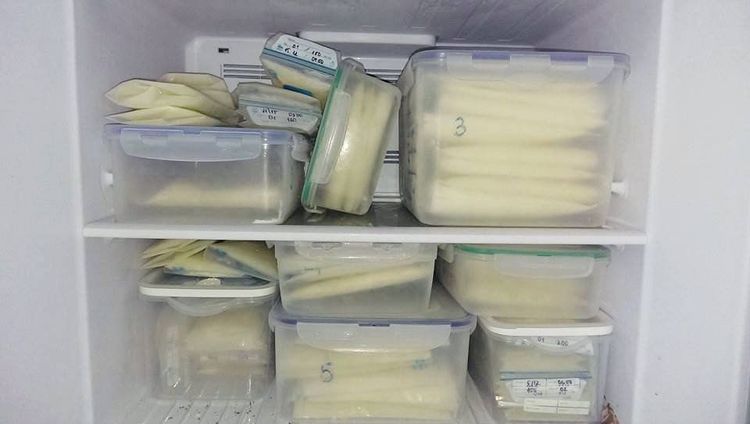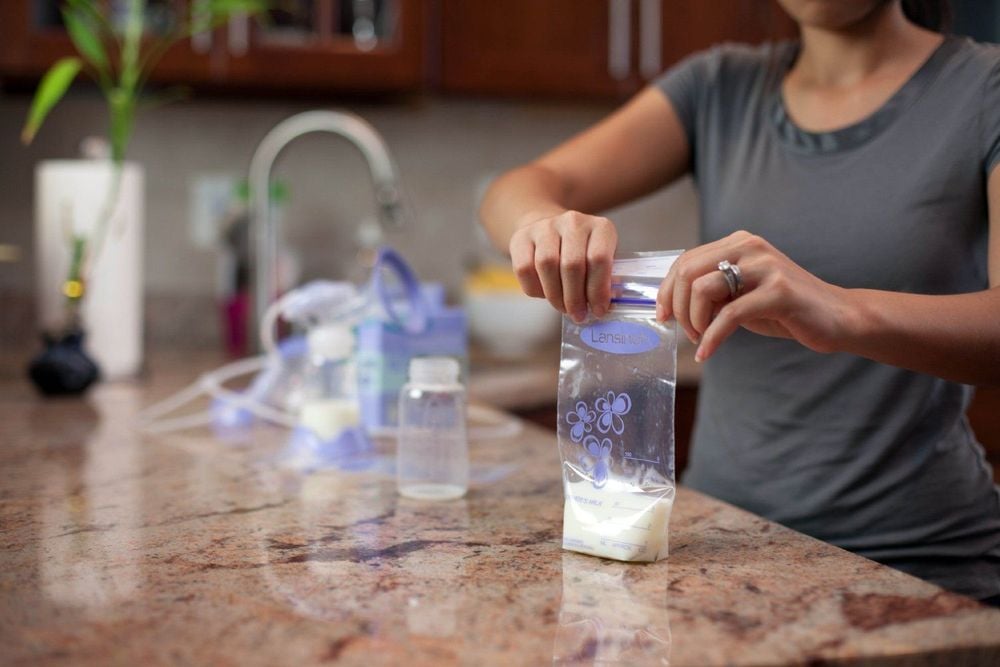This is an automatically translated article.
The article was professionally consulted by Dr. Le Thu Phuong - Department of Pediatrics - Neonatology - Vinmec Hai Phong International General Hospital.Breast milk is the best source of nutrition for infants and young children. However, mothers need to make sure that they have defrosted milk properly so that their baby has a nutritious breast milk supply.
1. Store expressed breast milk properly
After expressing breast milk, it should be stored in a refrigerator or by a freezer, although there will be a possibility of antibodies being reduced, but still ensure the nutritional value intact. Specifically: Breast milk can be kept in the refrigerator for 72 hours, the freezer for 1 month, and the freezer for 3 months. After reheating to eat only once, the excess milk must be discarded and cannot be reused.Mothers should know how to properly store breast milk, to keep nutrients for the baby: Expressed milk, should be stored in each plastic or glass bottle that has been bare of sterile boiling water, then note the time and date full month to distinguish old milk from new, expired or not, and arrange evenly on the freezer. Prioritize defrosting and reheating bottles that have been stored for the longest time.

Có thể bảo quản sữa mẹ trong ngăn lạnh hoặc ngăn đá
2. Instructions for defrosting milk properly
For breast milk stored in the freezer compartment:1 day before use, the mother should put the milk from the freezer compartment to the cooler to defrost but still keep the refrigerator temperature. Or you can defrost the milk in a basin of water, but it must be ice cold. When the milk has completely softened to a liquid form, the mother needs to gently shake it to mix the high-fat whey and clear milky parts. Then change the water to soak the milk into warm water to warm it to the right temperature for your baby to eat. Note: When you defrost by moving from the freezer to the cooler, you will see a thin layer of scum floating on the surface of the bottle, which is the essential fat in breast milk, before your baby just needs to shake the film. It will dissolve evenly in the milk. But when there is a phenomenon that precipitates into an opaque white cloud, it is damaged and cannot be used, not ensuring the quality and safety for the baby's digestive tract. For breast milk stored in the refrigerator compartment:
The mother takes the milk out of the refrigerator and soaks it in warm water of 40 degrees until it reaches the right temperature for the baby to eat. However, do not soak breast milk in too hot water because it will lose vitamins and minerals in breast milk. Breast milk, once removed from the refrigerator, cannot be frozen for further use. Therefore, mothers should only take the right amount of milk for each feeding.
3. Things to keep in mind when defrosting breast milk

Sữa mẹ sau rã đông đã hâm nóng chỉ để ở nhiệt độ phòng trong tối đa 4 giờ
Do not defrost by heating breast milk or defrosting milk in a microwave oven: because microwaves, electromagnetic waves and excessive heat will destroy essential vitamins and antibodies in milk, causing breast milk to lose some of its protein. as well as other valuable nutrients, uncontrollably hot milk can burn your baby.
Do not shake the defrosted milk bottle or change the temperature suddenly: because when shaking vigorously or changing the temperature suddenly, breast milk loses the function of antibodies, proteins that help protect the baby's body, and loses some nutrition. in the milk supply. Types of antibodies Lysozyme, Lactoferrin... will promote anti-inflammatory properties, or fight swelling of the intestinal mucosa only if they have the correct form of the original structure of the molecule. When some segments remain unchanged and some molecular segments are affected, the amino acid wall breaks, even though it has nutritional value, but loses its antibody ability.
Reheated thawed breast milk can only be left at room temperature for up to 4 hours or in the refrigerator for up to 24 hours.
Discard excess curd if your child does not use it up after 24 hours. After defrosting and warming breast milk, it should be used by the baby within 2 hours, if the baby has not eaten, you can keep it in the refrigerator, it should not be at room temperature. should be more than 24 hours. After 24 hours, mother should discard, absolutely do not mix excess curd with freshly expressed milk to use next time.
The taste of thawed breast milk changes: Sometimes thawed milk has an unpleasant odor to the baby. It is possible that the strange smell and sour taste is from an enzyme in milk called lipase. Lipase naturally breaks down milk fats during storage, however it is still safe to give milk to your baby. This unpleasant smell can only be clearly smelled by the mother. Most babies will still eat normally, but sensitive babies may not drink because they don't like the taste. If you still want to give your baby a good meal, you can boil the hot milk until small bubbles appear, then turn off the stove, absolutely do not boil.
Defrost breast milk properly seems easy but for many mothers it will be hard and difficult. Please apply the requirements above so that your child can get the most nutritious, safe and secure source of nutrition.
For more nutritional knowledge and child care for each age, parents should regularly visit the website vimec.com and make an appointment with the leading doctors, pediatric and nutrition experts of the National General Hospital. Vinmec when needing advice on children's health.














